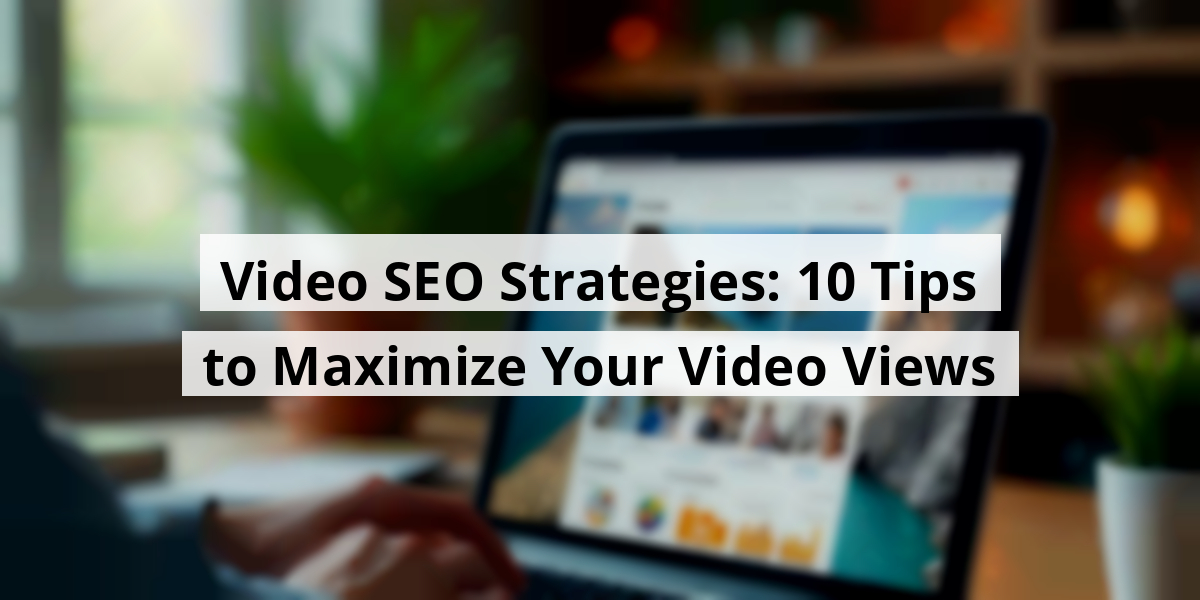
- 19th Aug '25
- KYC Widget
- 12 minutes read
Video SEO Strategies: 10 Tips to Maximize Your Video Views
In a world where cat videos and cooking tutorials rule the internet, video SEO is the unsung hero that helps great content shine. When I first dipped my toes into video creation, I thought simply uploading my content was enough. Spoiler alert: it wasn't! I learned the hard way that without solid SEO, my heartfelt videos were lost in a sea of competitors. There’s something thrilling about not only capturing the perfect shot but also knowing how to get people to see it. Through trial, error, and a few hilarious missteps (trust me, nobody needs to see that spaghetti monster I dubbed ‘pasta horror’), I’ve discovered the elements that can make your videos stand out. Let’s dig into video SEO and empower you to turn those clicks into loyal subscribers!Key Takeaways
- Video SEO is crucial to boost visibility and attract viewers.
- YouTube and Google SEO have unique strategies that cater to their audiences.
- Optimizing titles, descriptions, and tags can significantly impact video reach.
- Engaging thumbnails and captivating intros can capture attention instantly.
- Consistency in posting can build a loyal audience over time.
Now we are going to talk about why having a solid video SEO plan is crucial in our digital landscape.
The Significance of a Video SEO Approach
Have you ever found yourself scrolling endlessly through cat videos instead of tackling your to-do list? We can relate! But that’s where video SEO steps into the spotlight. Imagine this: it’s a Saturday afternoon, and you decide you want to learn how to bake a pie. You whip out your phone, open YouTube, and the real magic begins. The right video pops up, guides you step-by-step, and before you know it, you’re knee-deep in flour. You see, that’s the beauty of well-optimized video content. But wait, there’s more to it than just baking disasters! Let’s break down why a strong video SEO strategy can make or break our online presence:- Visibility: Everyone loves a good pie, but if the video isn’t optimized, who’s going to see it? We want our delicious recipes to shine like a beacon on the internet!
- User Engagement: Engaging content holds our audience's attention, keeping them glued to their screens. Let’s face it, no one wants a boring tutorial!
- Brand Recognition: A consistent approach helps establish our brand as an authority. Imagine being the go-to channel for pie lovers everywhere!
- Shareability: When our content is optimized, viewers are more likely to share it with friends, spreading our pie passion far and wide.
Now we are going to talk about the differences between YouTube SEO and Google SEO, which is a topic that often confuses many of us. It’s like comparing apples to oranges, or even better, like trying to solve a Rubik’s Cube while juggling. Both platforms have their quirks, but they each cater to different audiences and content styles.
YouTube SEO Versus Google SEO: What Sets Them Apart?
When we consider YouTube SEO and Google SEO, it's essential to recognize that they play in different playgrounds. For starters, YouTube is primarily a video platform. We’re often caught binge-watching cat videos or tutorials that tackle everything from cooking to coding. This means the algorithms prioritize engagement, which includes likes, comments, and shares. If your video isn’t eliciting a “wow” from viewers, it’s going to sink faster than a lead balloon. On the other hand, Google focuses on text-based content. Think blogs, articles, and—spoiler alert—lots of keywords. Instead of focusing on how long a viewer sticks around to watch your heated debate on the best pizza toppings, Google cares about the nuts and bolts of your written text and how well it answers a user's query. Both platforms have their own ranking signals:- YouTube loves watch time. The longer folks watch, the better you're treated.
- Google is a sucker for solid SEO practices, like keyword placement and meta descriptions.
- YouTube considers engagement metrics like comments and shares as a vote of confidence.
- Google focuses on links and authority—so build those backlinks, folks!
Now we are going to talk about some essential tips for optimizing video content. These practices can help ensure your videos reach the audience they deserve while potentially boosting your overall visibility online.
Top Tips for Video Optimization
 Ever find yourself lost in a sea of videos online? One moment you’re giggling at a cat trying to fit into a too-small box, and the next, you’re pondering the meaning of life after watching a thoughtful documentary. Clearly, there’s a lot happening, which is why optimizing our videos is as critical as finding that sweet spot where the cat video meets profound insight! Here are some ways to make your videos stand out:
Ever find yourself lost in a sea of videos online? One moment you’re giggling at a cat trying to fit into a too-small box, and the next, you’re pondering the meaning of life after watching a thoughtful documentary. Clearly, there’s a lot happening, which is why optimizing our videos is as critical as finding that sweet spot where the cat video meets profound insight! Here are some ways to make your videos stand out: - Engaging Thumbnails: Create eye-catching thumbnails that scream, “Click me!”
- Clear Titles: Use informative titles that spark curiosity. Think “The Secret Life of Cats” instead of “Video 123.”
- Captions and Subtitles: Make your content accessible to everyone, even those watching on mute in a crowded cafe.
Video Description Essentials
One might think writing a description is trivial—oh, how wrong they’d be! It’s akin to picking just the right wine to complement that lasagna. Here's what to include:| Element | Description |
|---|---|
| Keywords | Sprinkle relevant keywords naturally throughout the description. |
| Links | Include links to your website or social media for additional engagement. |
| Call to Action | Encourage viewers to subscribe, like, or comment—don’t be shy! |
Utilizing Social Media
Sharing is caring, right? Social media platforms are like the wide-open fields of content marketing. By posting videos across platforms, we grab more eyes (and hopefully hearts). Take inspiration from recent viral trends—TikTok is buzzing with creative snippets. It’s all about jumping on the bandwagon while keeping our unique flair intact. In conclusion, while crafting incredible videos takes skill, these video SEO strategies will help enhance our content, making every cat video or heartfelt documentary reach its full potential!Now we are going to talk about how to make our videos shine bright in search engine results. It's like giving them a virtual glow-up!
Video SEO Essentials: Making Your Clips Search-Friendly
When it comes to making videos that don't just sit there like a bump on a log, we all know the importance of SEO. It's like seasoning in cooking—too little and it’s bland; too much can ruin the dish! One time, we posted a video with a title so boring it made watching paint dry seem thrilling. And guess what? It tanked. The lesson? Engaging titles and descriptions are key! Here are some handy tricks to get started:- Title Magic: Use eye-catching but clear titles. Think about what would make you click!
- Descriptions Matter: Fill your video description with keywords without sounding like a robot. We want Google to love us, not pity us!
- Tags Are Your Friends: Use relevant tags to help categorize your video. No one wants their masterpiece getting lost in cyberspace.
Conclusion
Video SEO isn't just a buzzword; it's a compass pointing toward online visibility. I've been through the ups and downs of video marketing, and I can tell you, a little SEO goes a long way. By implementing these strategies, you can transform your casual uploads into viewer magnets. Just remember, every view counts, but engaged viewers? Well, they’re the icing on the cake!FAQ
- Why is having a solid video SEO plan important?
Having a solid video SEO plan is crucial for visibility, user engagement, brand recognition, and the shareability of your content, ensuring that it stands out in a crowded digital landscape. - How does YouTube SEO differ from Google SEO?
YouTube SEO focuses on video engagement metrics like watch time, comments, and shares, while Google SEO prioritizes text-based content with strong keyword usage and backlinks. - What role do titles play in video optimization?
Titles are essential in video optimization as they attract viewers; a catchy, informative title can significantly influence whether someone decides to watch your video or not. - What are some essential tips for optimizing video content?
Some essential tips include creating engaging thumbnails, using clear titles, and adding captions and subtitles to make content accessible. - What should you include in a video's description?
A well-crafted video description should contain relevant keywords, links to your website or social media, and a clear call to action to encourage viewer engagement. - How can social media enhance video visibility?
Sharing videos across various social media platforms increases visibility and can draw more viewers, leveraging trends and audience engagement. - Why are tags important for video SEO?
Tags help categorize your video, making it easier for viewers to find your content and improving its visibility in search results. - What is the ideal video length for engagement?
Aiming for a video length of about 7-10 minutes is ideal, as this duration tends to hold viewer interest without overstaying its welcome. - How can analyzing video performance help?
Analyzing video performance with tools like Google Analytics provides insights into what works and what doesn't, helping creators improve future content. - What is the significance of experimenting with content?
Experimenting with content allows creators to discover what resonates with their audience, fostering improvement and innovation in their video strategy.